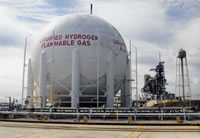
![]()
 |
| Liquid hydrogen storage tank (850,000 gallons) at NASA KSC (Photo: D. Wood) |
|---|
Storing hydrogen in a liquid state gives increased energy density and is a mature technology with its use in NASA’s Space Shuttle program as an excellent example. However, the issues with liquid hydrogen tanks are hydrogen boil-off, the energy required for hydrogen liquefaction, volume, weight, and tank cost. The energy demand for hydrogen liquefaction is high, consuming about 30 percent of the heating value of the hydrogen being liquefied. Hydrogen boil-off must be minimized or eliminated because of cost, efficiency, range considerations, and safety when vehicles are parked in confined spaces.
Liquid hydrogen tanks can store more hydrogen in a given volume than compressed gas tanks. The density of liquid hydrogen is 0.070 kg/L, compared to 0.030 kg/L for 10,000-psi gas tanks. For details on liquidification, power requirements, cycles and boil-off losses, see Liquid Hydrogen Storage [1.09MB PDF] at “Gaseous Hydrogen Storage at Hydrogen for Power Applications – Task 2.O Storage of Hydrogen in Solid, Liquid and Gaseous Forms” (pages 17-42).
